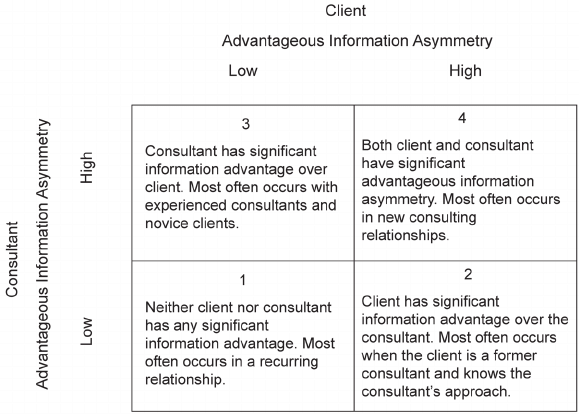When looking for software consulting services, people unfamiliar with development often suffer from knowledge asymmetry—the situation where one party knows far more about the topic at hand than the other.
This situation causes feelings of uncertainty and fear of associated with caveat emptor (buyer beware). And the result can be a painful relationship that often has one side or the other feeling like they’re on the defensive.
Knowledge Asymmetry Is All Around Us
It happens when you get all those bills after a visit to your doctor. Or when it’s time to sign up for next year’s health plan. How about that cable or cell phone bill with all its complicated charges? And especially when you buy something like a car or house; just think of all those closing papers you had to sign.
Daniel Pink does a great job explaining knowledge asymmetry in Chapter 3 of his book To Sell is Human. Using the sale of cars as an example, he describes the headaches when the seller know more about the product than the buyer. No one wants to buy a “lemon” of a car. And the seller doesn’t want to settle for a price lower than what the auto is worth. Neither party wants to feel like they’ve been made a fool. The worst part is when people who “pawn bad wares as good wares” drive out honest sellers.
Whenever you encounter situations of high complexity, you are bound to find knowledge asymmetry. The very nature of complexity requires a detailed understanding of the principles behind the problem and the solutions that are available. This is why you need a lawyer or accountant when dealing with complicated business situation. And there around bound to be people who are, unfortunately, taking advantage of it.
Knowledge Asymmetry in IT Consulting
Looking specifically at the world of IT Consulting, you find knowledge asymmetry at work right from the beginning of a relationship. RFPs (Requests for Proposal) are one attempt to find parity by identifying everything the client needs to pick the right consultant for a project. “Thick” contracts with detailed wording is another attempt to eliminate risk on either the client or consultants side. And having many meetings with lots of different people over a long-time frame is another.
One way this can be represented is by a two-by-two matrix chart found in “Information Asymmetry in Information Systems Consulting: Toward a Theory of Relationship Constraints” by Gregory S. Dawson, Richard T. Watson, and Marie-Claude Boudreau.

In the chart, you can see how the various situations between client and consultant play out. In quadrant 1 (Low/Low), since there is a balance in information, both client and consultant see the project as low risk. Consequently, contracts tend to be simple. The exact opposite is in quadrant 4 (High/High), both the client and consultant will set up high level constraints in detail contracts. This is the case when a consultant enters a new market containing unfamiliar clients and offers new services. In quadrant 2 (Low/High), the client has an advantage over the consultant which often leads to the consultant wanting a very detailed contract. This situation may result when the consultant is new to a particular market but the client is familiar with the consulting firm or the type of service to be provided. Finally, in quadrant 3 (High/Low), the consultant has an advantage over the client which often leads to the client wanting a very detailed contract.
At Atomic we tend to see quadrant 1 play out in our long-term client relationships. This is where we’ve developed a product and are either maintaining it or starting a new product. These contracts tend to be simple and straightforward. We also see quadrant 3 appear with our newer clients. Often times we have many meetings to work our project details. We are comfortable working through complicated MSAs and SOW contracts. And we understand that some clients have a corporate process that must be followed to manage risk.
Meeting Knowledge Asymmetry Head On
How do you avoid ending up with a software lemon? Start by educating yourself before getting into contract discussions with a software consultant. The internet is the best tool available for creating parity between buyers and sellers. Here are some questions you can ask yourself or actions that can help set yourself up for success.
1. Develop a good understanding of the problem you’re trying to solve.
I often start this by asking who is the enemy that is standing in the way of progress. Can you describe the promised land and know what success look like? One key is to recognize what you know and what you don’t know about your problem. Nathan Furr has an excellent article on the difference between know problems and solutions versus unknown problems and solutions.
2. Know why the problem needs to be solved now.
Why hasn’t it been solved already? What are the obstacles? Knowing the timing for what’s driving your needs will have a big impact on what needs to be built and its cost. Also, have a good sense for what’s driving your budget. There are always more ideas than money when it comes to custom software.
3. Research your options.
If the problem you are trying to solve is well defined and the solution is known, chances are there is a software product that already exists. If the problem you are solving is defined but the solution is unknown, then custom software may be right for you. Sometimes you will find yourself in a grey middle ground here. That may mean finding an existing software product and integration with other systems.
4. Find the right consulting firm for you.
Once you know you need a software consulting firm, start by talking to people in this industry. Often word-of-mouth can get you started in a direction. Or use Google and look to find software consultants who have solved a problems like yours.
Once you’ve found a few you like, visit their website and learn as much as you can about them. If they have a good blog, you can learn about their competencies, process, and past success stories. You should also learn as much as you can about their reputation to ensure they are fair and honest. You can do this by visiting them on social media sites like Facebook and learning what people say about them. You can also look at sites like Glassdoor to discover how their employees feel about working there.
Education Reduces Asymmetry
At Atomic we actively work to create balance in our relationships and reduce knowledge asymmetry. We recognize this is no easy task, since software development is complex and the world of IT changes constantly. So we constantly work to educate clients:
- Publishing on this blog and Great Not Big
- Providing stories about our projects to help buyers understand what it’s like working with Atomic.
- Starting all our engagements with pre-project consulting model to define a budget and a plan for success.
We’ve also designed our process and tools to manage risk. Software creation is risky and full of tradeoffs (there are often more ideas than budget). So we favor getting started quickly with small contract engagements to learn and discover if an idea can lead to a successful product. We look to make the right decisions at the right time. Most importantly, we do this by living our values through everything we do.
Atomic is always working to create a healthy and balanced relationship with clients. This starts by establishing trust with honesty and long-term thinking. That’s why we empower our clients with information and transparency throughout the buying process.

